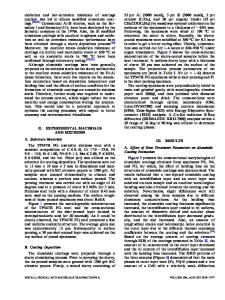Characterization of the Degraded Microstructures of a Platinum Aluminide Coating
- PDF / 3,282,807 Bytes
- 6 Pages / 612 x 792 pts (letter) Page_size
- 30 Downloads / 293 Views
Characterization of the Degraded Microstructures of a Platinum Aluminide Coating Hyungjun Kim and Mark E. Walter Mechanical Engineering Department, The Ohio State University Columbus, OH 43210, U.S.A. ABSTRACT To investigate phase evolution of β-(Ni,Pt)Al/γ΄-(Ni3Al) in thermal barrier coating bond coat systems, specimens were subjected to 1200 ºC cyclic and isothermal heating. By removing the thermally grown oxide (TGO) after every 10 hours of heating, aluminum (Al) depletion from the bond coat was accelerated. Non-accelerated and accelerated Al-depletion samples were examined with scanning electron microscopy after every 10 hours of cyclic and isothermal heating. Observations from after the first 10 hours of thermal exposure show distinct microstructural differences. After 50 hours of heating, cyclic accelerated Al-depletion samples show more distinct grain boundaries and a higher proportion of γ΄-(Ni3Al) phase than isothermal accelerated Al-depletion samples. Through instrumented micro-indentation, trends in elastic modulus were determined for isothermal and cyclic accelerated Al-depletion specimens. INTRODUCTION Thermal barrier coating (TBC) systems are applied to nickel based superalloys to improve the efficiency of gas turbines by allowing increased turbine inlet temperatures. An insulating ceramic topcoat lowers the temperature seen by the superalloy substrates, however, to further protect the substrate from oxidation and hot corrosion and to improve adhesion of the ceramic, bond coats are applied between the ceramic topcoat and the substrate. During high temperature exposure, a thermally grown oxide (TGO) grows between the topcoat and the bond coat. Due to its stable, slow growing TGO layer, platinum-modified aluminide (PtAl) coatings are one of the most popular types of bond coats for TBC systems. Understanding the bond coat and its degradation will enable better modeling and ultimately result in improved TBC systems. Although the TGO slows diffusion and oxidation, it also plays an integral role in the ultimate failure of the TBC system. In particular, it is thought that the stresses associated with TGO waviness are the main reason why small cracks develop and propagate at the TGO interface. Eventually the cracks link together and enable macroscopic spallation of the ceramic topcoat [1]. TGO wrinkling may occur and grow as a result of the decomposition of the β-(Ni,Pt)Al phase and precipitation of γ'-(Ni 3 Al) phases accompanied by a volume reduction in the bond coat [2]. Alternatively, the undulation amplitude of the TGO may increase through plastic ratcheting of the bond coat [3]. It has also been suggested that TGO instabilities happen on β-(Ni,Pt)Al phase and that γ'-(Ni3Al) phases resist downward TGO displacement [4]. To investigate phase changes in bond coat systems, 1200 ºC cyclic and isothermal heating was applied to a bond coat/substrate system. By removing the TGO after every 10 hours of heating, aluminum (Al) depletion from the bond coat was accelerated. Bond coats and substrates were examined wit
Data Loading...











